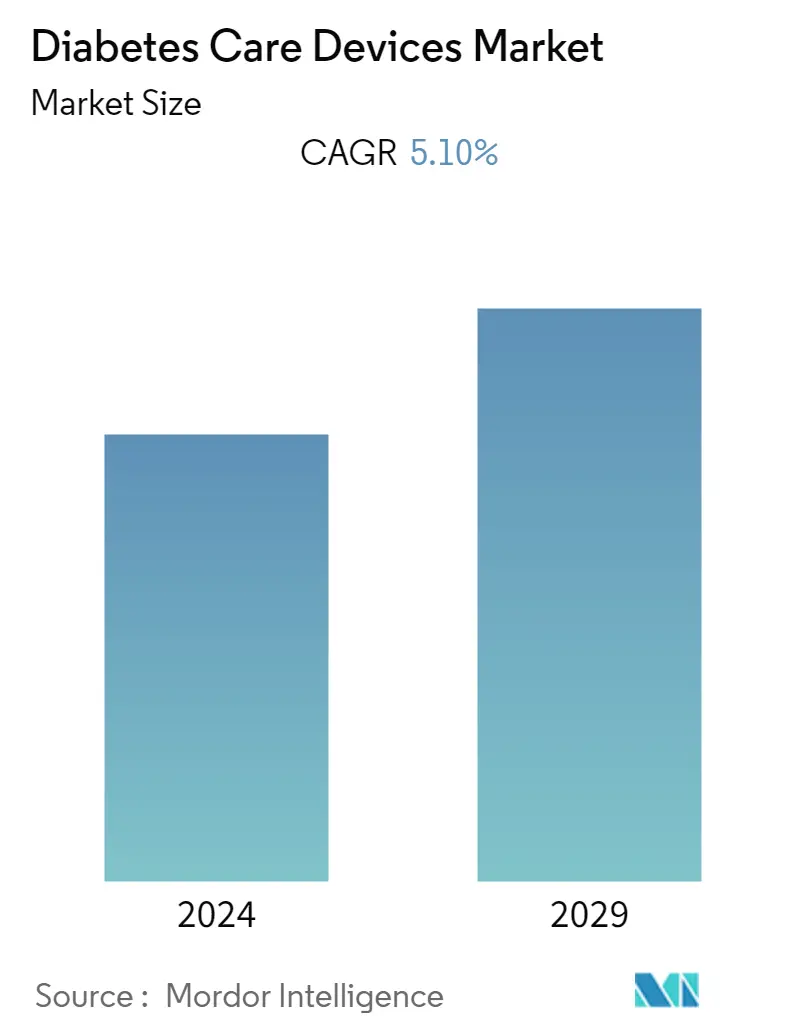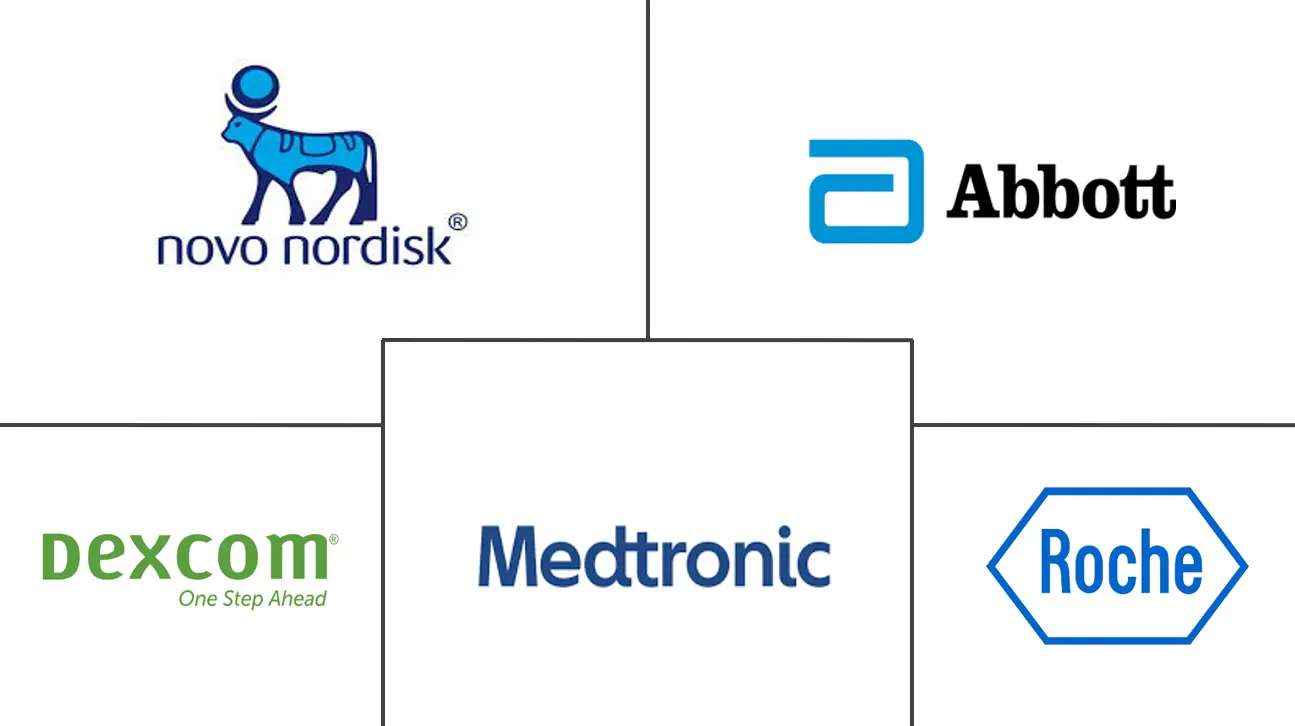Market Size of Diabetes Care Devices Industry

| Study Period | 2019 - 2029 |
| Base Year For Estimation | 2023 |
| Forecast Data Period | 2024 - 2029 |
| CAGR | 5.10 % |
| Fastest Growing Market | North America |
| Largest Market | North America |
Major Players
*Disclaimer: Major Players sorted in no particular order |
Need a report that reflects how COVID-19 has impacted this market and its growth?
Diabetes Care Devices Market Analysis
The Global Diabetes Care Devices Market size is estimated at USD 59,522.29 million in 2023 and is expected to reach USD 76,329.64 million by 2028, registering a CAGR of 5.10% during the forecast period (2023-2028).
The COVID-19 pandemic had a substantial impact on the diabetes care devices market. The pandemic highlighted opportunities for continuing and expanding innovations in the delivery of diabetes care through virtual consultations between healthcare providers and people with diabetes and the use of diabetes technology. Crisis management created unprecedented interest in remote care from patients and providers and removed many long-standing regulatory barriers. For instance, the US Food and Drug Administration allowed personal blood glucose meters and continuous glucose monitoring devices in hospitals during the pandemic. The prevalence of diabetes in people hospitalized with COVID-19 infection and the recognition that improved glycemic control might improve outcomes and reduce the length of stay in patients with SARS-CoV-2 underlined the importance of diabetes care devices.
According to the IDF 2021 report, the global adult diabetes population was approximately 537 million, which will increase by 643 million in 2030. Continued elevation in blood glucose levels in diabetes patients can contribute to progressive complications such as renal, nerve, and ocular damage. Appropriate and timely blood glucose monitoring allows the successful management of out-of-range blood glucose levels and minimizes diabetic-related health complications. Obesity is considered one of the major factors contributing to the disease, primarily Type 2 diabetes. In obese individuals, the fat cells in the body release pro-inflammatory chemicals, which may make the body less sensitive to the insulin it produces by disrupting the function of insulin-responsive cells. Thus, these individuals need external insulin shots and must use a glucose monitoring device like a glucometer.
Innovative technologies, such as digital health apps that display and summarize individual blood glucose measurements and incorporate additional relevant data such as insulin doses, meals, and physical activity, can further support self-management while decreasing disease burden and benefitting overall diabetes care. Integration of blood glucose monitoring with insulin calculators, automated insulin titration software, and remote coaching are further developments that provide patients with poorly controlled diabetes additional support needed to improve critical outcomes, thereby enhancing the market prospects in the years to come.
Diabetes Care Devices Industry Segmentation
Diabetes care devices are the hardware, equipment, and software used by diabetes patients to regulate blood glucose levels, prevent diabetes complications, lessen the burden of diabetes, and enhance the quality of life. The Diabetes Care Devices Market is segmented into Management Devices (Insulin Pumps, Insulin Syringes, Insulin Cartridges, Disposable Pens, and Jet Injectors), Monitoring Devices (Self-monitoring Blood Glucose and Continuous Glucose Monitoring), and Geography (North America, Europe, Asia-Pacific, Middle East and Africa, and Latin America). The report offers the value (in USD) and volume (in Unit) for the above segments. Further, the report will cover a segment-wise breakdown (Value and Volume) for all the countries covered under the Table of Contents.
| Monitoring Devices | |||||
| |||||
|
| Management Devices | |||||
| |||||
| Insulin Syringes | |||||
| Insulin Cartridges | |||||
| Disposable Pens | |||||
| Jet Injectors |
| Geography | |||||||||||||
| |||||||||||||
| |||||||||||||
| |||||||||||||
| |||||||||||||
|
Diabetes Care Devices Market Size Summary
The diabetes care devices market is poised for significant growth, driven by the increasing prevalence of diabetes and the rising demand for effective management solutions. The market has been influenced by the COVID-19 pandemic, which accelerated the adoption of remote care technologies and highlighted the importance of diabetes management in improving patient outcomes. Innovations such as continuous glucose monitoring (CGM) systems and digital health applications are transforming diabetes care by providing real-time data and facilitating better self-management. These advancements are supported by regulatory changes and technological improvements, which are expected to enhance the accuracy and accessibility of diabetes care devices.
North America, particularly the United States, is anticipated to lead the market growth due to its large patient base and the rapid adoption of advanced medical technologies. The availability of healthcare reimbursements and government initiatives to combat diabetes further bolster the market prospects in this region. The market is moderately fragmented, with major players like Dexcom, Medtronic, and Abbott competing to innovate and expand their market share. The integration of diabetes care devices with automated insulin delivery systems and the development of new glucose-sensing technologies are key trends shaping the market's future. As the demand for diabetes management solutions continues to rise, the market is expected to experience robust growth, offering substantial opportunities for both established and emerging players.
Diabetes Care Devices Market Size - Table of Contents
-
1. MARKET DYNAMICS
-
1.1 Market Overview
-
1.2 Market Drivers
-
1.3 Market Restraints
-
1.4 Porter's Five Forces Analysis
-
1.4.1 Bargaining Power of Suppliers
-
1.4.2 Bargaining Power of Consumers
-
1.4.3 Threat of New Entrants
-
1.4.4 Threat of Substitute Products
-
1.4.5 Intensity of Competitive Rivalry
-
-
-
2. MARKET SEGMENTATION
-
2.1 Monitoring Devices
-
2.1.1 Self-monitoring Blood Glucose
-
2.1.1.1 Glucometer Devices
-
2.1.1.2 Test Strips
-
2.1.1.3 Lancets
-
-
2.1.2 Continuous Glucose Monitoring
-
2.1.2.1 Sensors
-
2.1.2.2 Durables
-
-
-
2.2 Management Devices
-
2.2.1 Insulin Pumps
-
2.2.1.1 Insulin Pump Device
-
2.2.1.2 Insulin Pump Reservoir
-
2.2.1.3 Infusion Set
-
-
2.2.2 Insulin Syringes
-
2.2.3 Insulin Cartridges
-
2.2.4 Disposable Pens
-
2.2.5 Jet Injectors
-
-
2.3 Geography
-
2.3.1 North America
-
2.3.1.1 United States
-
2.3.1.2 Canada
-
2.3.1.3 Rest of North America
-
-
2.3.2 Europe
-
2.3.2.1 France
-
2.3.2.2 Germany
-
2.3.2.3 Italy
-
2.3.2.4 Spain
-
2.3.2.5 United Kingdom
-
2.3.2.6 Russia
-
2.3.2.7 Rest of Europe
-
-
2.3.3 Latin America
-
2.3.3.1 Mexico
-
2.3.3.2 Brazil
-
2.3.3.3 Rest of Latin America
-
-
2.3.4 Asia-Pacific
-
2.3.4.1 Japan
-
2.3.4.2 South Korea
-
2.3.4.3 China
-
2.3.4.4 India
-
2.3.4.5 Australia
-
2.3.4.6 Vietnam
-
2.3.4.7 Malaysia
-
2.3.4.8 Indonesia
-
2.3.4.9 Philippines
-
2.3.4.10 Thailand
-
2.3.4.11 Rest of Asia-Pacific
-
-
2.3.5 Middle East and Africa
-
2.3.5.1 Saudi Arabia
-
2.3.5.2 Iran
-
2.3.5.3 Egypt
-
2.3.5.4 Oman
-
2.3.5.5 South Africa
-
2.3.5.6 Rest of Middle East and Africa
-
-
-
Diabetes Care Devices Market Size FAQs
What is the current Global Diabetes Care Devices Market size?
The Global Diabetes Care Devices Market is projected to register a CAGR of 5.10% during the forecast period (2024-2029)
Who are the key players in Global Diabetes Care Devices Market?
Novo Nordisk A/S, Medtronic, Dexcom Inc., Abbott Diabetes Care and Roche Diabetes Care are the major companies operating in the Global Diabetes Care Devices Market.

